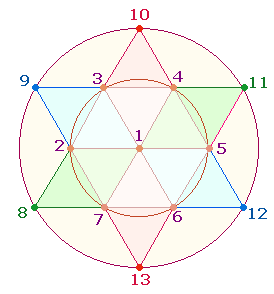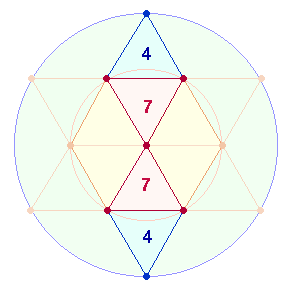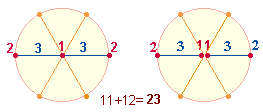Alphabets;
gematric calculator
Ovid's and Shakespeare's Epitaphs
SHAKESPEARE's 7 LETTERS
I. Geometrical
Models
II. Frequency of the 7 Letters in the
Epitaph
III. The Letters G and D
I.
Geometrical Models
1.
The spelling of Shakespeare's name as it is used today
first appeared as printed signature on the dedication page of "The Rape of
Lucrece" in 1594. It is different, however, in the six surviving
handwritten signatures.
I assume that Shakespeare decided on his official spelling also for
gematric reasons. As he observes all the rules which I have found essential in
the Roman gematric system, I will try to reconstruct some aspects. Information
about gematric values can be obtained in a separate article.
2.
The name SHAKE-SPEARE consists of two syllables and 5+6 = 11 letters. It clearly bears connotations of
the words SHAKE
and SPEAR,
whose bellicose association give the name some attractiveness. The initial S of the two syllables form
a kind of alliteration.
The
name contains 7
different letters, 4
occur more than once. The basis of numerologic meaning is the hexagon and, as
its extension, the hexagram and two corresponding concentric circles:
|
|
The graphic shows the hexagram with its two opposite tetractyses, each
consisting of 10 points.
From the perspective of one tetractys, 3 more points are left.
One hexagonal axis consists of 5 diametrical elements. As each of the two radial lines
is delimited by two points, also 6
radial elements can be counted. If the radial lines and the points are
separately counted, this double aspect produces 4 lines and 7
points. If the centre points are counted separately, the partition is 3+8.
A
triangle consists of 7 elements. The
hexagon contains three double triangles, which are extended to three double
rhombi. The 7
elements of a triangle are extended by 4 more elements to form a rhombus:
|
|
II. Frequency of the 7 Letters in the Epitaph
1. Under these gematrical
aspects Shakespeare understood his name (FV
= factoral value):
|
|
S |
H |
A |
K |
E |
sm |
S |
P |
E |
A |
R |
E |
sm |
tot |
|
NV |
18 |
8 |
1 |
10 |
5 |
42 |
18 |
15 |
5 |
1 |
17 |
5 |
61 |
103 |
|
FV |
8 |
6 |
1 |
7 |
5 |
27 |
8 |
8 |
5 |
1 |
17 |
5 |
44 |
71 |
|
sm |
|
|
|
|
|
69 |
|
|
|
|
|
|
105 |
174 |
|
69:105 = 3*( |
||||||||||||||
The numerical
sum (NS) 103 refers to 10+3 points of the hexagram. The seven different
letters produce the following results:
|
|
S |
H |
A |
K |
E |
P |
R |
sm |
|
NV |
18 |
8 |
1 |
10 |
5 |
15 |
17 |
74 |
|
FV |
8 |
6 |
1 |
7 |
5 |
8 |
17 |
52 |
|
sm |
|
|
|
|
|
|
|
126 |
|
126 = 6*21 |
||||||||
As
one tetractys consists of 37 elements, the
number 74 represents two tetractyses. One
double rhombus consists of 21 elements. A
cross of double rhombi can be folded into a octahedron.
So the number 126 means
three octahedra. One octahedron is composed of 4 double triangles and 4*13 = 52
elements.
The seven
different letters have the same gematric values as Shakespeare's first name WILLIAM, that also
consists of 7 letters, 5 of which are different.
|
|
W |
I |
L |
L |
I |
A |
M |
sm |
|
NV |
21 |
9 |
11 |
11 |
9 |
1 |
12 |
74 |
|
FV |
10 |
6 |
11 |
11 |
6 |
1 |
7 |
52 |
|
sm |
|
|
|
|
|
|
|
126 |
2. Shakespeare
determined the frequency of the 7 different
letters of his name in his epitaph to establish a relation to the rest of the NS:
|
|
S |
H |
A |
K |
E |
P |
R |
|
|
NV |
18 |
8 |
1 |
10 |
5 |
15 |
17 |
74 |
|
frequ. |
14 |
4 |
7 |
1 |
21 |
1 |
7 |
55 |
|
sm |
252 |
32 |
7 |
10 |
105 |
15 |
119 |
540 |
The
NS of Shakespeare's epitaph is 1242 = 54*23. So the letters of his name produce an NS ratio of 54*(
1. The numerical value
(NV) of G and D are 7 and 4, which represent the predominant theme of the
epitaph in the very first word GOOD. The NS of OO is 28, which shows the same
numbers in the product 4*7 and is also the number of the epitaph's words.
2. The two letters appear
only in the first two lines in 4 words: GOOD FRIEND DIGG DUST. The NS of 3 G
and 5 D is 21+20 = 41, referring to the elements of the axes of
double rhombi.
3. There is a
remarkable inversion of the two letters in GOOD and DIGG. This reqires
remembering that the NS of IESUS and MARIA are 70 and 40 with corresponding
ratio 10*(7:4). It means that IESUS as the Second Divine Person is the creator
of MARIA before MARIA conceived and bore IESUS in his two natures of God and
Man, which might be indicated by double G. But the two G also refer to the
hexagram with its concentric circles whose area ratio is 1:3, thus representing the one God in Three
Persons. Each circle consists of a midpoint and 6 points on the circle line.
But in reality one sees only one midpoint. So one has to count 13 (DI) + 14
(GG) = 27. The trinitarian idea of 1:3 is already present in the Latin word DI
– Gods.
Formed
as a three digit number, 477 is 9*53 = FV 59. Both 53 and 59 are relatable to
the diameter of the hexagram: 5 elements of
the hexagonal axis and 9 elements of hexagram diameter represent the area ratio
1:3. The number 5 and 3 imply the same ratio, referring to the radial elements of the two circle axes.
In
the same sens the 3+5 letter G and D have to be understood.
The 4values of DIGG
reveal some more trinitarian relevance:
|
|
NS |
FV |
sm |
FS |
FV |
sm |
tot |
|
DIGG |
27 |
9 |
36 |
24 |
9 |
33 |
69 |
If the FV are added to their corresponing sums, the ratio
of the results is 36:33
= 3*(
|
|
NS+FS and FV1+FV2 are the usual combination of the 4values:
|
|
NS |
FS |
sm |
FV1 |
FV2 |
sm |
tot |
|
DIGG |
27 |
24 |
51 |
9 |
9 |
18 |
69 |
|
|
ROTA |
S |
|
||||
A
circle with three hexagonal axes represents a wheel turning, in Latin ROTA. If you add an S,
it means you turn round. So there is a logic
connection between DIGG and ROTA: But it's SATOR
– the creator who turns mortality into
immortality, any mortal effort to uncover human remains is therefore without
sense, it's even sacrilege if curiosity and research endevour to take
possession of what the deceased has given up to God.
4. The 4values of the four words are:
|
|
NS |
FS |
sm |
FV1 |
FV2 |
sm |
tot |
|
GOOD |
39 |
29 |
68 |
16 |
29 |
113 |
|
|
FREND |
45 |
44 |
89 |
11 |
15 |
26 |
115 |
|
sm |
84 |
73 |
157 |
27 |
44 |
71 |
228 |
|
DIGG |
27 |
24 |
51 |
9 |
9 |
18 |
69 |
|
DVST |
61 |
40 |
101 |
61 |
11 |
72 |
173 |
|
sm |
88 |
64 |
152 |
70 |
20 |
90 |
242 |
|
tot |
172 |
137 |
309 |
97 |
64 |
161 |
470 |
|
84:88 = 4*(21:22) = 4*43 > FV 47 |
|||||||
The
total result 470 contains the equivalent
numbers for D and G
again.
The
words GOOD FREND
are spoken from an attitude of kindness and benevolence. If G
and D
stand for IESUS and MARIA,
Shakespeare, by the NS 74 of his first name WILLIAM, partakes in Jesus' and Mary's affection
for all human beings, and at the same time knows himself
protected by them.
The
NS+FS 309 = 3*103 contains
Shakespeare's NS 103 three times.


